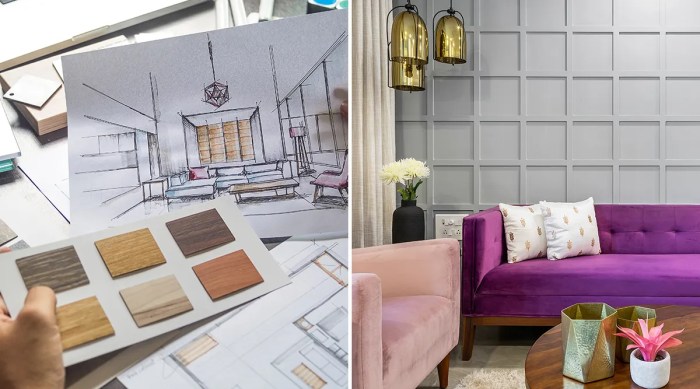Delve into the world of architecture and interior design where creativity meets functionality. Learn about the dynamic responsibilities and collaboration between architects and interior designers in shaping our built environments.
Role of an Architect and Interior Designer

An architect plays a crucial role in a construction project, responsible for designing and planning the overall structure of buildings. On the other hand, an interior designer focuses on creating functional and aesthetically pleasing interior spaces.
Primary Responsibilities of an Architect
- Developing building designs based on client needs and requirements
- Creating detailed construction plans and blueprints
- Ensuring compliance with building codes and regulations
- Collaborating with engineers and contractors throughout the construction process
- Overseeing the project to ensure it meets the design specifications
Key Tasks of an Interior Designer
- Understanding client preferences and functional needs
- Creating interior layouts and selecting appropriate furniture and decor
- Choosing color schemes, materials, and finishes for the space
- Collaborating with architects and contractors to ensure design vision is executed
- Providing guidance on lighting, acoustics, and other interior elements
Comparison of Roles
| Architect | Interior Designer |
| Focuses on the overall structure and exterior of buildings | Concentrates on creating functional and visually appealing interior spaces |
| Emphasizes on structural integrity and building codes | Emphasizes on aesthetics and user experience |
| Collaborates closely with engineers and contractors | Collaborates closely with clients and other design professionals |
| Responsible for the building's exterior appearance and functionality | Responsible for the interior layout, decor, and ambiance |
Education and Training
To pursue a career as an architect or interior designer, individuals must undergo specific educational and training requirements. Here, we will explore the paths to becoming a licensed architect and interior designer, as well as the significance of ongoing professional development in these fields.
Architect Educational Requirements
Becoming an architect typically requires a combination of education, work experience, and licensure. The educational path usually involves obtaining a professional degree in architecture from a program accredited by the National Architectural Accrediting Board (NAAB). This can include a Bachelor of Architecture (B.Arch) or a Master of Architecture (M.Arch) degree.
Additionally, aspiring architects must complete a period of practical training through internships or apprenticeships.
Interior Designer Licensing Process
Licensed interior designers follow a similar path in terms of education and training. While requirements vary by state, most states mandate that interior designers have a minimum of a bachelor's degree in interior design from an accredited institution. Graduates may also need to gain work experience under a licensed interior designer before becoming eligible for licensure.
Interior designers may also choose to earn certifications in specialized areas such as lighting design or sustainable design.
Importance of Professional Development
Continuous learning and professional development are crucial for architects and interior designers to stay abreast of the latest trends, technologies, and regulations in the industry. This can involve attending workshops, conferences, or pursuing advanced certifications. By investing in ongoing education, professionals can enhance their skills, expand their knowledge base, and maintain their licensure status.
Design Process
When it comes to the design process in architecture and interior design, there are specific steps and approaches that professionals follow to create functional and aesthetically pleasing spaces.
Architectural Design Process
The architectural design process typically involves the following steps:
- Programming: This initial phase involves gathering information about the project requirements, objectives, and constraints.
- Schematic Design: Architects create rough sketches and drawings to explore different design options and concepts.
- Design Development: Once a concept is selected, architects develop it further with more detailed drawings and plans.
- Construction Documents: Detailed drawings and specifications are created to communicate the design intent to contractors and builders.
- Construction Administration: Architects oversee the construction process to ensure that the design is implemented correctly.
Interior Design Approach
Interior designers approach the design phase by focusing on the functionality and aesthetics of interior spaces. They consider factors such as space planning, color schemes, furniture selection, lighting, and finishes to create cohesive and harmonious interiors that meet the client's needs and preferences.
Tools and Software
Architects and interior designers utilize various tools and software to enhance their design process, such as:
- Computer-Aided Design (CAD) software: Allows professionals to create detailed 2D and 3D drawings of their designs.
- Building Information Modeling (BIM) software: Enables architects to create intelligent 3D models that contain data about the building elements.
- Rendering software: Helps visualize designs in photorealistic images or animations for client presentations.
- Virtual Reality (VR) and Augmented Reality (AR) tools: Allow clients to experience the design in a virtual environment before construction begins.
- Material and finishes libraries: Provide a database of textures, colors, and materials for designers to select from for their projects.
Collaboration and Communication
Effective communication between architects and interior designers is crucial for the success of any project. It ensures that the vision and goals of the design are clearly understood and executed throughout the process. Clear and open communication helps in avoiding misunderstandings, conflicts, and delays, leading to a more cohesive and harmonious final result.
Significance of Effective Communication
Effective communication between architects and interior designers allows for the seamless integration of architectural elements and interior design concepts. It enables both professionals to share their ideas, provide feedback, and make decisions collaboratively. By maintaining constant communication, they can ensure that the final design meets the client's requirements and expectations.
Strategies for Successful Collaboration
- Establishing clear project goals and objectives from the beginning.
- Holding regular meetings to discuss progress, challenges, and decisions.
- Creating a shared vision board or digital platform to exchange ideas and inspiration.
- Assigning clear roles and responsibilities to each team member.
- Utilizing digital tools for real-time collaboration and document sharing.
Benefits of Interdisciplinary Teamwork
Collaboration between architects and interior designers brings together different perspectives, expertise, and skills to create innovative and holistic design solutions. It allows for a more comprehensive approach to space planning, functionality, aesthetics, and sustainability. By working together, professionals can leverage their strengths to deliver a design that is not only visually appealing but also functional and practical for the end user.
Sustainability and Innovation

In today's architectural and interior design landscape, sustainability and innovation play crucial roles in shaping the built environment. Architects and interior designers are increasingly integrating sustainable practices into their projects to reduce environmental impact and create healthier spaces for occupants.
At the same time, innovative design trends are constantly emerging, pushing the boundaries of traditional design concepts and exploring new possibilities in both architecture and interior design.
Integration of Sustainable Practices
Architects and interior designers are incorporating sustainable practices such as passive design strategies, use of recycled materials, energy-efficient systems, and green building certifications into their projects. By prioritizing sustainability, they aim to minimize the environmental footprint of buildings and promote a more eco-friendly approach to design.
Innovative Design Trends
- Biophilic design: Incorporating elements of nature into built environments to enhance well-being and connection to the natural world.
- Adaptive reuse: Repurposing existing structures for new functions, reducing waste and preserving architectural heritage.
- Smart technology integration: Utilizing advanced technologies to improve efficiency, comfort, and convenience within buildings.
- Modular construction: Prefabricated components that allow for faster construction times and reduced material waste on-site.
Impact of Technological Advancements
Technological advancements such as Building Information Modeling (BIM), virtual reality, and 3D printing have revolutionized the way architects and interior designers work. These tools enable better visualization, collaboration, and efficiency in the design process, leading to more innovative and sustainable solutions for both new construction and renovation projects.
Closing Notes
Discover the intricate dance of creativity and technical expertise as architects and interior designers work together to bring visions to life. Explore the endless possibilities in sustainable practices, innovative design trends, and the evolving impact of technology in this dynamic field.
Key Questions Answered
What are the primary responsibilities of an architect?
Architects are responsible for designing and overseeing the construction of buildings, ensuring they are functional, safe, and aesthetically pleasing.
What key tasks does an interior designer perform?
Interior designers focus on creating functional and visually appealing interior spaces by selecting furniture, colors, and decor.
What is the typical path to becoming a licensed interior designer?
Becoming a licensed interior designer usually involves completing a degree program, gaining work experience, and passing a licensing exam.
How do architects and interior designers collaborate effectively?
Effective communication, mutual respect for each other's expertise, and a clear division of responsibilities are key to successful collaboration.
How do architects and interior designers integrate sustainable practices into their projects?
Architects and interior designers incorporate sustainable materials, energy-efficient systems, and green design principles to minimize environmental impact.






